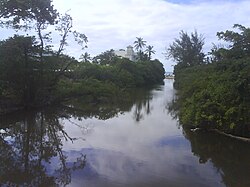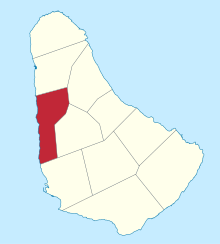
Back Saint James (Barbados) Breton Saint James (parokya) CEB Saint James (Barbados) German Άγιος Ιάκωβος, Μπαρμπάντος Greek Sankta Jakobo (Barbado) Esperanto Parroquia de Saint James (Barbados) Spanish سنت جیمز، باربادوس Persian Saint James (Barbade) French Saint James (Sarkspal uun Barbaados) FRR Saint James, Barbados ID
Saint James | |
|---|---|
 | |
 Map of Barbados showing the Saint James parish | |
| Coordinates: 13°13′N 59°37′W / 13.217°N 59.617°W | |
| Country | Barbados |
| Largest city | Holetown |
| Government | |
| • Type | Parliamentary democracy |
| • Parliamentary seats | 3 |
| Area | |
• Total | 31 km2 (12 sq mi) |
| Population (2010 census) | |
• Total | 28,498 |
| • Density | 920/km2 (2,400/sq mi) |
| ISO 3166 code | BB-04[1] |
The parish of Saint James ("St. James") is an area located in the western central part of the country of Barbados. Increasingly St. James is becoming known as the playground of the rich and famous, and as a haven for sun-starved tourists with its up-market hotel resorts.[2]
In local colloquium, St. James was known as the "Gold Coast", but due to its ongoing popularity, it is now often referred to as the "Platinum Coast", reflective of the parish's many glitzy beach-front mansions, pristine beaches, luxury hotel resorts, and consistently high land prices.
The parish also has great historic significance, as it was here that the first British settlers landed in 1625. Under the authority of King James, the British claimed Barbados upon landing in St. James' present-day town of Holetown (formerly known as Jamestown, named after the King himself); this settlement turned Barbados into what would later be known colloquially as "Little England".
Noted for its shopping and restaurants in Holetown, Saint James, is central to Barbados' bustling tourist industry,[citation needed] with historical attractions including the St. James Parish Church and the Portvale Sugar Factory, one of the few remaining operational sugar factories on the island.
Though the beach area is a haven for wealthy tourists and foreign expatriates, St. James as a whole is far from exclusive. As one of the bigger parishes of Barbados, it is home to over 20,000 nationals in its various districts, across various social strata. The parish is home to the prestigious Queen's College, one of the foremost schools not only in Barbados, but also the Caribbean, founded over a century ago by British plantation owner Colonel Henry Drax. At its most rural, the parish's many villages (such as the seafront Fitts Village) are abuzz with activity, near-familial camaraderie, and an active social atmosphere.
- ^ iso:code:3166:BB, International Organization for Standardization
- ^ Tyzack, Anna (19 February 2010). "Property in the Caribbean: Welcome to Barbados". The Daily Telegraph. Archived from the original on 22 February 2010. Retrieved 24 June 2010.